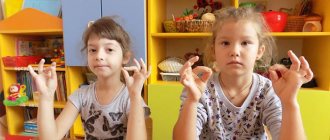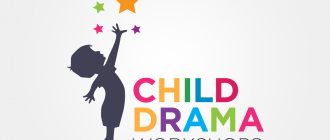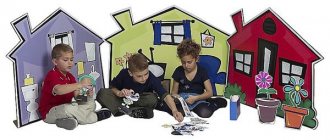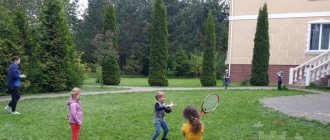Breathing is the energetic basis of spoken speech. The development of speech breathing largely determines the child’s formation of coherent speech, namely correct sound pronunciation, the ability to maintain normal speech volume, its smoothness and intonation expressiveness. By paying attention to establishing the correct speech breathing of the baby in early childhood, you can avoid many speech disorders in the future. In this article we will tell you about the features of speech breathing and ways of its development in preschool children.
Features of speech breathing in preschoolers
Speech breathing in preschool children differs from the breathing of adults and has its own characteristics:
- Insufficient development of the respiratory apparatus. If the inhalation and exhalation are weak, then the child’s speech will sound quiet and unintelligible. Sometimes, due to lack of air, children do not finish sentences. There are times when the baby tries to pronounce the entire phrase while inhaling, so he speaks quickly and does not observe logical pauses. Poor development of the respiratory system may be associated with the presence of chronic respiratory diseases in the child, such as sinusitis and sinusitis, as well as a sedentary lifestyle.
- Irrational distribution of exhaled air. Children who have recently learned to speak often run out of air on the first syllable, so they pronounce the end of a word or phrase much more quietly or even “swallow” it.
- Inability to distribute breathing according to words. To replenish the smell of the air, the child has to take a break, during which he may forget what he wanted to say.
- Speech sounds may be distorted due to improperly exhaled air.
Speech breathing in most preschool children is imperfect. But it is often difficult for parents to notice this due to the fact that they communicate with the baby constantly.
There are approximate norms for the number of words pronounced on exhalation, which can be used as a guide when assessing a baby’s speech breathing:
| Child's age | Number of words per exhale |
| 2-3 years | 2-3 words |
| 3-4 years | 3-5 words |
| 4-6 years | 4-6 words |
| 6-7 years | 5-7 words |
Card file of speech motor exercises for preschoolers
Play is the main activity of preschoolers, regardless of their age: junior, middle or senior. Therefore, exercises should be carried out in a playful way, be exciting, emotionally charged, and arouse interest.
Two basic speech exercises for a child:
- Exercise "Giraffes". Children stretch their noses to the ceiling, stretching their necks. They remain in this position for some time, then return to their original position.
- Exercise "Pebbles". Preschoolers imitate how they use both hands to collect small pebbles in both hands separately. Keep your fists clenched for a while, then relax your hands, as if scattering pebbles.
How to breathe correctly?
When diagnosing speech development, speech therapists always pay attention to how the child breathes during a conversation, the strength and duration of his inhalations and exhalations, and how he places pauses. Formation of speech breathing is one of the first stages of correctional work with a child who has any speech disorders. Correct speech breathing has the following signs:
- Short breath through the nose;
- Exhale smoothly, the air comes out through the mouth;
- Exhalation is carried out to the end;
- After each exhalation there should be a short pause (2-3 seconds).
The development of speech breathing is closely related to the functioning of physiological breathing.
| Physiological respiration | Speech breathing |
| Involuntary | free |
| Inhale - exhale - pause | Inhale - pause - exhale |
| Inhalation and exhalation are carried out in one impulse. | Inhalation is carried out with one impulse, exhalation - with several (depending on the content of the statement). |
Only by learning to breathe correctly (deep short inhalation and smooth long exhalation) will a child be able to fully master his voice. The most effective methods of working with preschoolers are breathing exercises. Conventionally, they can be divided into two large groups, depending on their purpose:
- Formation of correct exhalation;
- Breathing training using various speech materials (practicing the pronunciation of sounds and their combinations, learning poetry).
The development of speech breathing in preschoolers allows:
- Speed up the process of staging and automating speech sounds;
- Increase the number of words that the baby pronounces in one exhalation;
- Form intelligible, coherent speech;
- Coordinate the processes of speech, breathing and movements.
What role does air play in speech?
A person will not be able to utter a single word if the air does not pass through the vocal cords. The flow should come out slowly and evenly. You can speak only during exhalation, when the chest with a certain effort squeezes air out of the lungs. The jet must pass not only with the required force, but also in the right direction. An adult does not notice these subtleties; his conversation occurs automatically, without the participation of consciousness.
To understand how difficult it is for a baby to learn to speak, try saying the shortest phrase yourself, inhaling and exhaling randomly. The child needs help; mom and dad should do this. It is useless to explain to him the structure of the speech apparatus, the work of the vocal cords. With a two-year-old, you don’t need to conduct lessons, but play; with the help of interesting exercises, he himself will begin to speak correctly.
Important!
If you have followed all the recommendations, but have not noticed a positive result, contact a speech therapist. A professional will identify the causes of incorrect speech and eliminate them.
There may be a person in your environment who does not know how to breathe correctly when speaking. If the child loves this guest, he can adopt his manner. Don’t laugh at your friend, explain to your child that no one taught Uncle Petya to breathe correctly; if the kid wants to help him, let him first start speaking correctly himself, and then teach his friend. Such an incentive will strengthen the baby’s desire to perform the exercises correctly.
Recommendations for performing breathing exercises
- Classes must be carried out in a well-ventilated area;
- All exercises should be performed before meals;
- Clothing should not hinder the baby's movements;
- The muscles of the child’s neck, shoulders, arms, chest and abdomen should be relaxed;
- Inhalation should occur through the nose;
- The exhalation should be long and smooth;
- Make sure that when performing breathing exercises, the child does not puff out his cheeks. At first, you can hold them with your palms;
- 3-5 repetitions of each exercise are enough, between which you should take a 2-3 second pause. The total duration of breathing exercises should not exceed 5 minutes.
It is very important to measure the amount of breathing exercises and perform them at a moderate pace to avoid hyperventilation.
www.Logopedy.ru
Abdullina Guzel Irikovna, teacher-speech therapist, MBDOU kindergarten No. 1 “Solnyshko” in the village of Yazykovo, Blagovarsky district, rep. Bashkortostan
Original:
Certificate of Publication:
Correct speech breathing is the basis of sounding speech. It ensures normal voice and sound formation, maintains smoothness and musicality of speech. With proper speech breathing, the baby will be able to pronounce sounds correctly, speak loudly, clearly, expressively, smoothly and observe the necessary pauses. The very first thing that is important for a child to learn is to exhale strongly and smoothly through the mouth. The baby needs to learn to control the time of exhalation, use air sparingly, and also direct the air stream in the right direction. Everyone knows what an important role the breathing apparatus plays in the life of every person. The birth of a baby begins with the first breath and, following this breath, a cry. However, you cannot be sure that if a child is breathing, then everything will be fine with his speech.
Correct physiological breathing does not imply correct speech breathing. This is due to the fact that the respiratory apparatus not only performs the main physiological function - gas exchange, but also participates in the formation of sound and voice. It is thanks to correct speech breathing that we change the volume of speech, make it smooth and expressive. Speech breathing is a person’s ability to make a short, deep entrance and rationally distribute air when exhaling while simultaneously pronouncing various sound combinations. Only correct speech breathing allows a person to expend less muscle energy, but at the same time achieve maximum sound and smoothness.
Speech breathing occurs voluntarily (the person controls himself), while non-speech breathing is performed automatically. When speaking, a person controls the inhalation and exhalation, changing it and ensuring smoothness, duration and ease of utterance. As our experience shows, young children in the process of speaking often begin to speak at the input or at the residual output. There are cases when children take a deep breath before pronouncing each word. Undoubtedly, this negatively affects the mastery of correct pronunciation and the construction of a smooth and coherent speech utterance. If a child speaks poorly, then work on speech development should begin, first of all, with the development of breathing.
Various games and exercises help develop breathing. What is it for? Proper breathing will help your child learn to speak calmly, smoothly, and slowly. Some breathing exercises also help teach the child how to pronounce certain sounds correctly. If a child puffs out his cheeks while speaking, then his speech is slurred precisely for this reason. And before you start making sounds, you need to teach your child how to properly produce an air stream.
The objectives of the work on the development of speech breathing are: 1) developing the skills of correct speech breathing; 2) strengthening the muscles of the face and chest; 3) prevention of diseases of the upper respiratory tract and nervous system; 4) increasing the mental performance of children; 5) normalization of sound pronunciation and prosodic components of speech; 6) consolidation of lexical topics and grammatical categories; 7) stimulation of interest in classes.
Breathing exercises improve posture, stimulate the movements of the diaphragm, improve blood circulation, and harmonize the activity of the respiratory, nervous and cardiovascular systems. Breathing is a reflex act and occurs without the intervention of human consciousness. But on the other hand, breathing is a controlled process when it is directly related to speech production. This breathing is called speech (phonation, or sound) breathing, and it requires special training. The development of breathing is one of the first and very important stages of correctional influence on children - speech pathologists, regardless of the type of their speech defect.
What is the difference between speech breathing and normal breathing? Breathing in human life is involuntary; it performs the function of gas exchange in the human body. Inhalation and exhalation are performed through the nose; they are short and equal in time. The sequence of physiological breathing is inhalation, exhalation, pause. For speech, especially monologue, physiological breathing is usually not enough. Speech and reading aloud require a large amount of air, a constant respiratory supply, its economical use and timely resumption, regulated by the respiratory center of the brain. In the initial stage of mastering speech breathing, will and consciousness are involved, aimed at performing the desired breathing task. Such voluntary speech breathing, achieved only through training, gradually becomes involuntary and organized.
It is imperative to breathe through the nose; the habit of breathing through the mouth has a very harmful effect on the human body, leading to diseases of the thyroid gland, tonsils, and the entire respiratory system. Nasal breathing protects the throat and lungs from cold air and dust, ventilates the lungs well, the cavity of the middle ear, which communicates with the nasopharynx, has a beneficial effect on the blood vessels of the brain. It is imperative to breathe through your nose in everyday life and when performing breathing exercises. The role of proper nasal breathing and breathing exercises in a person’s life is enormous. Breathing exercises are successfully used as a valid method of treating diseases of the upper respiratory tract (runny nose, laryngitis, pharyngitis, bronchitis), bronchial asthma, and neuroses. Healthy people can use breathing exercises to prevent many diseases. In speech breathing, inhalation and exhalation are not equal; the latter is much longer than the inhalation. The breathing sequence is also different. After a short inhalation, there is a pause to strengthen the abdominal muscles, and then a long sound exhalation. Since speech sounds are formed during exhalation, its organization is of paramount importance for the establishment of speech breathing and voice, for their development and improvement. Therefore, the ultimate goal of training speech diaphragmatic-costal breathing is to train a long exhalation, to train the ability to rationally use up the air supply during speech. To do this, it is necessary to train the muscles involved in the respiratory process and holding the chest in an expanded state not to relax passively immediately after exhalation. Relaxation should occur gradually as needed, obeying our will. To develop this type of breathing, educational and training exercises will be given below to develop and strengthen the diaphragm, abdominal and intercostal muscles.
Do you like the article? Tell your friends!
The formation of speech breathing is carried out throughout the entire work with the child. Unfortunately, parents do not always pay due attention to breathing defects. This is partly understandable: they are not very noticeable in the general condition of the child. But even a minor “malfunction” of nasal breathing has a harmful effect on the entire body. After all, a child takes more than 20 inhalations and exhalations per minute! And all this air must pass without any obstacles through the “entrance gate” - the nose. Here it is cleansed, warmed, moisturized and becomes what the body needs.
Why is it harmful to breathe through your mouth? Firstly, much less air enters the lungs; only their upper sections will work, which means the body will receive less oxygen. Secondly, the voice changes, speech is disrupted, the child begins to nasal and speak monotonously. In addition, it becomes more difficult for him to chew food. The sense of smell becomes dull due to a “bad nose,” and appetite disappears. Improper breathing also affects the teeth: they gradually become curved and caries can develop. And that's not it. The fluid that washes the brain stagnates, and substances harmful to the nervous system accumulate in it. Therefore, children who breathe through their mouths are irritable, whiny, absent-minded and lethargic.
These facts demonstrate how important it is to monitor the breathing of young children. If your baby, while climbing the stairs, doing exercises, doing some of his business, keeps his mouth open or sleeps with his mouth open, if he breathes frequently, has become lethargic, pale, and his lips are constantly chapped and covered with cracks - these are the first symptoms that he gets used to breathing incorrectly. What to do if a child breathes through his mouth? First of all, be patient and persistent. Breathing can be trained. Special exercises are recommended, the task of which is to learn to breathe only through the nose. Individual techniques should be practiced until normal nasal breathing becomes habitual. Here is the simplest exercise - closing the mouth “with a lock” (all exercises are in a playful form): the mouth is closed with the fingers or covered with the palm and the child is asked to breathe only through the nose. Gradually the mouth is closed for longer and longer periods of time. After a few days, the exercise becomes more complicated: they do it while walking. To strengthen the muscles of the nose, mouth, and throat, it is useful to read aloud more. You need to speak clearly and understandably. The child can control himself by loudly pronouncing the consonant sounds [b], [v], [zh], [m], [p], [t], [f], [sh], monitoring his breathing while performing this exercise. The following exercise is very useful: inhale and exhale slowly 5-6 times, closing your mouth. The hands should be placed on the back of the neck or on the upper abdomen. Systematic sound gymnastics classes are carried out with the child after appropriate consultation with a doctor. They restore breathing through the nose and increase emotional tone. This method of treating patients after adenotomy should be preferred. Here are some exercises. Exercises to strengthen the muscles of the respiratory apparatus. After breathing rhythmically, close your mouth tightly. Repeat the consonant sounds [b], [v], [m], [p], [t], [zh], [sh], [f] at rhythmic intervals. The air seems to be pushed out through the nose.
Of interest to modern scientists is the study of the possibility of using breathing exercises to improve the health of sick and weakened children, as well as the beneficial effects of these exercises on the body of a healthy child. The respiratory cycle consists of three phases: inhalation, exhalation and pause. During physiological breathing, inhalation and exhalation occur only through the nose. In the process of speaking and singing, exhalation occurs mainly through the mouth, while inhalation occurs simultaneously through the nose and through the mouth. During physiological breathing, according to V. G. Ermolaev, N. F. Lebedeva, V. P. Morozov, the ratio of the duration of inhalation and exhalation ranges from 1:1 to 1:2; during singing or talking, the duration of the exhalation phase can be 12, 20 and even 30 times longer than the inhalation phase. O. V. Pravdina points to the same ratio of inhalation and exhalation - 1:20, 1:30, but believes that inhalation will occur mainly through the mouth (the path of inhaled air through the mouth is shorter and wider than through the nose, therefore it occurs faster and more inconspicuous). E.D. Dmitrieva believes that during long stops, air must be inhaled through the nose, and during short stops (to get air), inhalation must be done through the mouth. O.Yu. Ermolaev, a supporter of the three-phase breathing system, argues that inhalation should be carried out exclusively through the nose.
The smoothness of the sound of speech depends on speech breathing. Moreover, it often depends not on the amount of air taken at the moment of inhalation, but on the ability to rationally spend it in the process of speaking. To maintain its smoothness, lightness and duration, it is necessary not only to rationally spend air in the process of speaking, but also to get it in a timely manner. An important point in mastering correct speech breathing is the question of what type of breathing a person uses during a speech utterance. Physiologists distinguish and distinguish three main types of breathing: thoracic, abdominal and mixed. It has been established that the most correct and convenient for speech is costal-diaphragmatic breathing, in which the lungs are ventilated evenly in all parts. Currently, most researchers prefer this type of breathing, as they regard it as the most beneficial for the body. With this type of breathing, during inhalation, the shoulders do not rise, the abdominal press moves forward somewhat, the ribs move apart, and air fills all the lungs. During exhalation, air leaves the lungs, the ribs move closer together, and the abdominal muscles fall. Correct speech breathing ensures normal sound production, creates conditions for maintaining normal speech volume, strictly observing pauses, maintaining fluency of speech and intonation expressiveness.
The speech breathing of preschoolers differs sharply from the speech breathing of adults: it is characterized by weakness of the respiratory muscles and small lung volume. Many children use upper chest breathing and often inhale with a sharp rise in their shoulders. Some children do not know how to expend air rationally during the process of speaking; they often take in air almost before every word.
Imperfections of speech breathing in preschoolers: 1. Very weak inhalation and exhalation, which leads to quiet, barely audible speech. This is often observed in physically weak, sedentary, shy children. 2. Uneconomical and uneven distribution of exhaled air. As a result of this, the preschooler sometimes exhales all the air on the first syllable and then finishes the phrase or word in a whisper. Often, because of this, he does not finish speaking and “swallows” the end of a word or phrase. 3. Inept distribution of breathing according to words. The child inhales in the middle of the word (the doll and I sing - (inhale) - we're going for a walk). 4. Hasty pronouncing of phrases, without interruption and while inhaling, with “choking.” 5. Uneven jerky exhalation: speech sounds either loud or quiet. 6.Weak exhalation or incorrectly directed exhaled air stream, in turn, leads to distortion of sounds.
Work on the formation of speech breathing includes the following stages: *Expanding the physiological capabilities of the respiratory apparatus (establishing diaphragmatic-costal breathing and forming a long exhalation through the mouth). *Formation of prolonged phonation exhalation. *Formation of speech exhalation.
The formation of speech exhalation is of fundamental importance for the organization of smooth speech. It is known that fluency of speech is a holistic, continuous articulation of an intonationally and logically completed segment of an utterance in the process of one continuous exhalation.
In preschool age, the formation of diaphragmatic breathing must be carried out at the initial stage in a lying position. In this position, the muscles of the whole body relax slightly, and diaphragmatic breathing is established automatically without additional instructions.
In the future, various game techniques are used to train diaphragmatic breathing, its strength and duration. In this case, the following guidelines should be taken into account. * Breathing exercises should be organized in such a way that the child does not focus on the process of inhalation and exhalation. * For preschool children, breathing exercises are organized in the form of a game so that the child can involuntarily take a deeper breath and exhale longer. * All exercises for training speech breathing are associated with performing two main movements: the arms move from the “to the sides” position “in front” with the girth of the chest, or from the “up” position they move down. Body movements are usually associated with bending down or to the sides. * Most exercises for preschool children include exhalation with articulation of consonants (mainly fricatives) or phonation of vowel sounds, which allows the speech therapist to auditorily control the duration and continuity of exhalation, and subsequently forms biological feedback in the child.
The child is in a supine position. The child's hand rests on the upper abdomen (diaphragmatic region). The child’s attention is drawn to the fact that his stomach is “breathing well.” You can put a toy on your stomach to attract attention. This exercise lasts on average 2-3 minutes. The exercise should be performed effortlessly to avoid hyperventilation and increased muscle tone.
Blow out the candle Children hold strips of paper about 10 cm from their lips. Children are asked to slowly and quietly blow on the “candle” so that the flame of the “candle” is deflected. The speech therapist notes those children who blew on the “candle” the longest.
The tire burst Starting position: children spread their arms in front of them, depicting a circle - “tire”. As they exhale, children slowly pronounce the sound “sh-sh-sh”. At the same time, the arms are slowly crossed, so that the right hand rests on the left shoulder and vice versa. The chest contracts easily during exhalation. Taking the starting position, children involuntarily inhale.
Inflate a tire Children are asked to inflate a “burst tire.” Children “clench” their hands into fists in front of their chests, taking an imaginary “pump” handle. Slowly bending forward is accompanied by exhaling to the sound “ssss.” When straightening, inhalation is involuntary.
Balloon The exercise is similar to the “Burnt Tire” exercise, but while exhaling the children make the sound “f-f-f”.
Hedgehog Starting position: bend your arms at the elbows and place them on your belt. Exhaling, children say “puff-puff-puff”, moving their elbows forward. Taking the starting position, children involuntarily inhale.
Crow Starting position: raise your arms up through your sides. Slowly lowering their arms and squatting, the children pronounce a drawn-out “K-a-a-a-r.” The speech therapist praises those “crows” that slowly descended from the tree to the ground. Taking the starting position, children involuntarily inhale.
Geese Starting position: place your hands on your belt. Slowly tilt your torso forward without lowering your head down. Say “G-a-a-a” in a drawn-out manner. Taking the starting position, inhale. The duration and strength of exhalation can be trained in exercises such as: * Exhale to a mental count (inhale on a count of 1-2-3; exhale: 4-5-6-7-8 to 15). * Pronounce slot sounds (s, sh, f, etc.) while exhaling, controlling the duration of exhalation with a stopwatch. * “Exhale and roll” an imaginary cotton ball along the length of your entire arm.
In the future, the diaphragmatic type of breathing must be trained when performing physical exercises (walking, bending and turning the body, etc.).
One of the common mistakes in working on the formation of speech breathing is excessive filling of the lungs with air during inhalation. Inhaling too much creates excessive tension in the respiratory muscles, creating conditions for hyperventilation. The next stage of work is the development of prolonged phonation exhalation. The formation of phonation exhalation is the basis for the development of coordinating relationships between breathing, voice and articulation. To avoid fixating attention on the process of inhalation, the instructions should concern only the duration of the sound.
After children have mastered the long pronunciation of one vowel while exhaling, they are asked to pronounce the combination of their two vowels together on one exhalation A______ O______. The number of vowel sounds pronounced on one exhalation in the following order gradually increases: A - O - U - I (standard vowel sounds). The child can control diaphragmatic inhalation and exhalation during these exercises with the palm placed on the diaphragm area. In addition to auditory control, the duration of phonation exhalation can be controlled by smooth hand movements.
The next stage of working on breathing includes the formation of the actual speech exhalation. Syllables, words, phrases are introduced into the exercises. When learning new skills, it is necessary not only to explain, but also to demonstrate it multiple times and to connect various types of control (auditory, visual, kinesthetic). Training should be systematic, long-term and included in all types of activities conducted with children.
Since the formation of speech breathing is closely related to the formation of the skill of rational vocal delivery and voice guidance, these tasks are solved almost simultaneously.
Work to overcome speech disorders in preschool children, carried out in a specialized kindergarten or group, is implemented through the use of a step-by-step system of speech formation. Considering the fact that a number of speech disorders have in their symptoms the syndrome of impaired physiological and speech breathing, this work is complex in nature and includes the “staging” of correct physiological and speech breathing. For this purpose, static and dynamic breathing exercises are used, aimed at developing the ability to breathe through the nose, developing oral exhalation, the ability to differentiate nasal and oral exhalation, and rationally use exhalation at the time of pronouncing sounds, syllables, words, phrases.
Performing breathing exercises in a playful way causes a positive emotional mood in the child, relieves stress and contributes to the formation of practical skills. While doing breathing exercises, a child will find himself in a special microworld of fairy tales, songs, games, and poems.
Fairy tales are a popular genre loved by children. In modern pedagogy and psychology, a fairy tale is considered as a source of child development that is diverse in its capabilities. Particular attention is paid to the close connection between the fairy tale and the game. Through fairy tales and motifs, the child is more easily included in the proposed type of activity.
Poems are short rhymed lines (rows), correlated and commensurate with each other. Poems are well remembered and emotionally perceived by children. Explanations regarding the meaning of the exercises, methods of performing them, or the rules of the game are better perceived and remembered by children if presented in the form of poems or short rhymes. The poem itself may contain some kind of fairy-tale plot calling for play.
Music is an auxiliary tool necessary to create a positive emotional mood, an atmosphere of creativity and fantasy. A music director can provide assistance in selecting a musical repertoire to accompany breathing games and exercises.
Singing is a form of breathing exercises that develops the vocal apparatus, strengthens the vocal cords, and improves speech. The systematic use of singing has a pronounced positive dynamics in the indicators of external respiration function. There is an increase in the vital capacity of the lungs, reserve volumes of inhalation and exhalation, a simultaneous decrease in the frequency and minute volume of breathing, as well as a decrease in respiratory energy costs.
Work on the formation of correct physiological and speech breathing in children with speech pathology, carried out in a specialized group of a preschool educational institution, involves solving the following tasks: *Improve the function of external (nasal) breathing. *Produce deeper inhalations and longer exhalations. *Develop phonation (voiced) exhalation. *Develop speech breathing. *Train speech breathing while pronouncing the text.
A child who has mastered proper breathing needs constant monitoring and monitoring of the correctness of his breathing. Hence the need for constant repetition of breathing exercises to consolidate the skills of correct physiological and speech breathing. All work on the formation of physiological and speech breathing, which is carried out in a preschool educational institution, requires the participation of the following specialists: speech therapist, teacher, music director, physical education instructor, psychologist, medical workers. In speech therapy work, the game method is widely used, which involves the use of various games, exercises of a playful nature in combination with other techniques: demonstration, explanation, instructions and questions. In the practice of correctional education and upbringing of preschool children, breathing games and exercises aimed at developing correct physiological and speech breathing are widely used. Special games and exercises are described in the manuals: G.A. Volkova, V.I. Seliverstova, E.N. Krause, I.A. Povarova, R.I. Lalaeva, S.E. Bolshakova, N.G. Komratova and etc. Regular exercises for the development of speech breathing, carried out by a speech pathologist in classes and teachers in a group, will ensure normal sound pronunciation, create conditions for maintaining the volume of speech, strictly observing pauses, maintaining fluency of speech and intonation expressiveness. In addition, they will strengthen the child’s health, increase his mental abilities, and correctly shape the child’s breathing.
List of used literature. 1. Fedyukovich N.I. Human anatomy and physiology: Textbook. — Ed. 2nd. - Rn/D: Phoenix, 2003. - 416 p. 2. Tkachenko B.I. Normal human physiology. — 2nd ed. - M.: Medicine, 2005. - 928 p. 3. Speech therapy: textbook for students. defectol. fak. ped. higher textbook establishments. / Ed. L.S. Volkova. ? 5th ed. ? M.: Vlados, 2008. - 703 p. 4. Semenova K.A., Mastyukova E.M., Smuglin M.Ya. Clinical symptoms of dysarthria and general principles of speech therapy. // Speech therapy. Methodological heritage. In 5 books. ? Book I: Disturbances of the voice and sound-pronunciation aspect of speech: At 2 o'clock? Part 2: Rhinolalia. Dysarthria: a manual for speech therapists and students. defectol. faculties of pedagogy universities / Shakhovskaya S.N. and etc.; edited by L.S. Volkova. ? M.: Vlados, 2006. ? 303 pp. 5.Belyakova L.I., Dyakova E.A. Stuttering. Textbook aid for students ped. institutes for special “Speech therapy”. - M.: V. Sekachev, 1998. - 304 p.: ill. 6.Verbovaya N.P., Golovina O.M., Urnova V.V. The art of speech. ? M., 1977. 7. Kochetkova I.N. Paradoxical gymnastics by Strelnikova. ? M., 1989.
Social commentary Cackle
Exercises to develop the strength and duration of exhalation
- Breeze. Tie several ribbons of serpentine or Christmas tree rain to a thread or lace. Invite your baby to blow on them and create a breeze. You can make the task more difficult by asking them to blow on ribbons of a certain color. The distance between the face and the ribbons should be approximately 10-15 cm.
- Leaf fall. Cut out real autumn leaves from paper or collect them from the street. Together with your child, you can arrange a real leaf fall by blowing them off the table. In the winter season, you can also play with paper snowflakes.
- Fly, feather! Let the baby throw the feather up and blow on it from bottom to top, not letting it fall.
- Pencil athletes. Draw start and finish lines on the table. At the start, put two pencils of different colors. Take turns blowing with your child on his own pencil and arrange a competition to see which of them will “run” to the finish line first.
- Sailors. Make boats out of paper or cork and lower them into a basin of water. There is a strong wind at sea - we blow on the ships, forcing them to move.
- Blow out the candles. You can role-play a birthday situation with your child. Prepare a toy set, cake and real candles. By blowing out the candles, you can make a wish.
- Pinwheel. A fidget toy is great for creating proper exhalation. Children love to watch the rotating blades and are proud of the result of their efforts.
- Whistles with the sounds of various animals and birds will also delight the baby and will be very useful for the development of his speech breathing.
- Another simple way to practice breathing is using soap bubbles.
Make sure that the child makes smooth and long exhalations. Gradually make the exercises more difficult by increasing the distance between your face and the object being deflated.
Games with various objects
There are many games you can come up with to train how to exhale correctly. Bring into the house a pinwheel with which the child runs along the street, and tell him that he himself can become the master of the wind. Let him blow on the blades with different strengths and watch them spin faster and slower. Buy a Chinese souvenir “wind chime” and hang it at the level of the child’s face so that he can blow and listen to the ringing of the bells as he passes by. In the same way, you can install a balancer, where on the planks in a state of balance there are bird figures that move at the slightest breath.
Many children already know that on their birthday they need to blow out the candles on the cake. Unfortunately, such an event occurs once a year, but for toys you can organize a holiday at least every day. Cover the doll table, seat the birthday boy and guests around, place lighted candles on cookies or gingerbread and invite the child to blow them out. Be sure to praise if it works the first time. Sometimes the baby cannot direct the stream in the right direction, so the first few times you can blow through a tube.
It seems that toy manufacturers are not interested in promoting proper breathing in children. To get the soap bubbles loved by all generations, you no longer need to blow into a straw. The kid takes the frame in his hand, waves it, and a whole swarm of rainbow balls flies into the air. Teach your baby to play with soap the traditional way. First, take a tube with a diameter of about 5 mm and teach how to create a storm in the water. Throw a small boat into the jar, when the baby releases air into the water, waves will form bubbles, and the toy will begin to sway. Immediately warn that liquid cannot be sucked into the mouth; air can only be released out. At first, use drinking water.
When you are sure that the child does not swallow the liquid, you can use a soapy solution to play. Now you can take a cocktail straw and create soap bubbles. You can take the composition from a toy or dilute baby shampoo with water in a 1:1 ratio. First, show your child how to blow into a straw to create thick foam in the glass. Then learn how to blow bubbles. To make it more interesting for your child, tell him to put on woolen gloves, then the ball caught on his hand will not burst immediately.
Exercises to practice correct pronunciation of sounds and syllables
To teach your baby to correctly pronounce vowels and consonants, syllables and sound combinations, you need to train them to pronounce them in one exhalation. Invite your baby to sing “songs” that imitate various sounds:
- “Ahhh!” - the baby is crying;
- "Uh-oh!" - the plane is flying;
- “Y-y-y!” — the steamer is humming;
- “Oh-oh-oh,” the bunny sighs;
- “F-f-f” - the balloon deflates;
- “Sh-sh-sh” - the snake hisses;
- “Ssss” - the pump is running;
- “Beep!” - the car honks;
- “Too-too” - the locomotive is moving;
- “La-la-la” - the doll sings;
- “Top-top-top” - the bear goes;
- “Drip-drip-drip” - it’s raining.
To engage your child, create a playful situation using your child’s favorite toys in class. Reinforce your speech with appropriate actions, and let the baby repeat after you.
Exercises to train the respiratory system for children from 5 to 7 years old
"Flower and Dandelion"
While standing, the child inhales through his nose, imagining that he is smelling a fragrant flower, then exhales air through his mouth onto the dandelion.
"Cheerful Hamster"
For this exercise, the child imagines himself as a hamster, filling his cheeks with air. Then, with a light clap on the cheeks, he releases air and sniffs his nose several times, looking for new food.
"The Dragon"
The child breathes through each nostril in turn, imagining himself as a fire-breathing dragon, while pinching each nostril with his finger.
Breathing method of A. N. Strelnikova
This method appeared in the 70s to treat people suffering from asthma. It consists of 14 physical and breathing exercises based on inhalation. The chest is compressed due to bending and turning. Body movements and inhalation should be simultaneous. These activities are suitable for children aged 3 years and older.
- We stand straight, hands down. Inhaling, we clench our hands into fists, then take 4 loud and small breaths and exhale. Repeat the exercise many times with short breaks.
- We stand straight, hands in fists. Inhaling, we unclench our hands and repeat the exercise 8 times with a short break.
- Bend with a stick from side to side, leaning on it. Inhale - tilt in one direction, exhale, straighten up, inhale again - tilt in the other direction, exhale, straighten up.
All the described exercises aimed at developing the respiratory system are carried out using the diaphragm and intercostal muscles. The diaphragm helps to obtain the necessary pressure in the chest and abdominal cavity. When performed correctly, the exercises, which take place in the form of a game, affect 4 types of breathing:
- Lower. The exercise involves the diaphragm. The lower and middle parts of the lungs are saturated with air.
- Average. The exercise involves the intercostal muscles, expanding the chest.
- Upper. The chest is motionless. Thanks to the movement of the shoulders and collarbone, the upper part of the lungs is saturated with air.
- Mixed. Air passes to all parts of the lungs.








